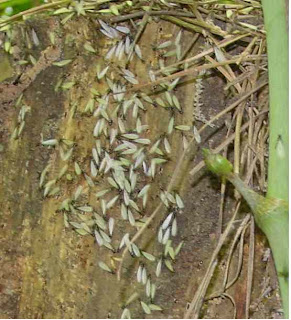As a young boy growing up and visiting my grandparents, I can remember seeing little webbed tents in my grandfather’s apple trees. He would tie handfuls of sage grass into a torch and burn them out before they could defoliate his apple trees. If they were not controlled in time the could completely defoliate the trees. The trees could grow new leaves, but the defoliating would affect the apple crop. They also are found on wild cherry, crabapple, hawthorn, maple, peach, pear and plum trees. I was warned not to handle the hairy worms because they might sting, but these were not stinging caterpillars. I was soon shown by the older kids how to hold and allow the caterpillars to crawl on my hands.
The caterpillars hatch from shiny, black egg masses that were glued to small pencil sized twigs. The egg masses encircle the branches and the caterpillars begin to hatch in early March. While feeding for 4 to 6 weeks the caterpillars grow to a length of 2 to 2 ½ inches. The larvae are black with a white stripe down the back, brown and yellow bands along the sides, and a row of oval blue spots on the sides. As the caterpillars grow, they enlarge their web, eventually it will be more than a foot in length. The larvae remain within the tent during the heat of the day and during rainy weather. They emerge to feed during the early morning early evening and at night when it is warm enough to do so.
When they reach maturity, the larvae begin crawling on plants, sidewalks, drive ways and on the sides of houses. The phone calls begin. If the defoliation has not been excessive, the webs in the trees often go unnoticed. When the whole yard is crawling with black caterpillars with racing stripes, people notice. By this time the damage has been done, and the larvae are seeking a protected place to pupate. We also get calls about the tiny cocoons on shrubs, the side of houses, in flower beds and other sheltered places. The adult moths will emerge in about 3 weeks, they are about an inch long. They are reddish-brown in color with two diagonal pale strips across the fore wings. After emerging they mate and the females attach the egg masses to the branches, to begin the cycle the next spring.
Removing the egg masses during the winter is one of the best management tools. While the tents are still small in the early spring they are easy to remove and destroyed by hand. Larger tents may be wound upon the end of a stick and pulled from the tree. The webbing, shelters the larva from insecticidal applications and the tent must be torn open or saturated with water before the application can penetrate the web. Parasitic wasps are important predators of the tent caterpillars and greatly reduce the populations in some years. Other insect predators and a few diseases also help to regulate the eastern tent caterpillar populations.


